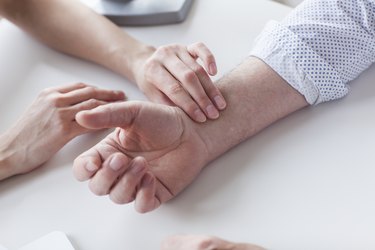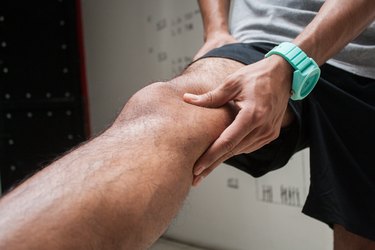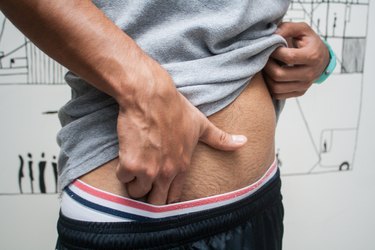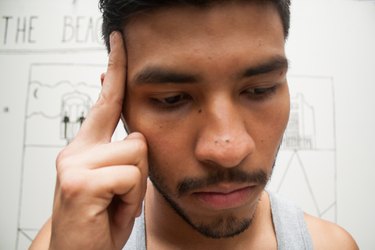
The pulse is most commonly checked on the wrist or neck, according to the Mayo Clinic, but there are other places on the body where a pulse can be examined.
The pulse can be felt anywhere an artery runs close to the surface of the skin, according to Mount Sinai. Use two fingers to apply slight pressure to the site and you should be able to feel the pulse.
Video of the Day
Video of the Day
When you find your pulse, count the number of beats for a minute, or count for 30 seconds and multiply by two, per the U.S. National Library of Medicine.
Tip
You can feel your pulse at your wrist, neck, knee, groin, temple, foot and elbow.
1. Wrist

Run your fingers along the outside of the wrist, just under the thumb. This is the position of the artery that runs from your heart to your hands (radial artery), per the Mayo Clinic.
Along with the neck, the wrist is the best place to check the pulse because the artery runs close to the skin and the bones create a firm place to feel the heart rate.
Tip
Use the tips of two or three fingers to feel for the pulse. The tips of your fingers are most sensitive to the movement of the artery.
2. Neck

Apply pressure to the side of the neck, just under the back of the jaw. This is the location of the artery sending blood from your heart to your head and brain (carotid artery), per the Mayo Clinic.
This is another easy-to-reach place to check your heart rate.
3. Knee

Check behind the knee for the popliteal pulse. This artery sends blood to your lower extremities.
Again, using the tips of your fingers is best, because they're most sensitive to the rhythm of your artery.
It can be difficult to find the pulse in this area, though. If checking the pulse here is too difficult, go to another location on the body.
4. Groin

You can also find a pulse in the groin area, where the leg meets the pelvis. The femoral artery here sends blood to your lower extremities.
However, the amount of muscle and fat in this area can make it difficult to find the pulse.
5. Temple

Press firmly to the side of and behind the eye to feel the temporal pulse.
The thin layer of fat and muscle here usually allows for the pulse to be easily felt at this location.
6. Foot

Check for a pulse along the top ridge (dorsalis pedis) of the foot or on the inside of the foot, just below the ankle bone (posterior tibial). The latter is typically easier to feel for most people.
7. Elbow

Test your pulse rate on the inside bend of the elbow (the brachial pulse). Fully extend your arm and feel inside the crook of your elbow, close to your body.
This isn't a common place to take a pulse because it can be tricky to find. It's easiest to feel the pulse here when there's a tourniquet on the arm, such as before a blood draw.
Was this article helpful?
150 Characters Max
0/150
Thank you for sharing!
Thank you for your feedback!


